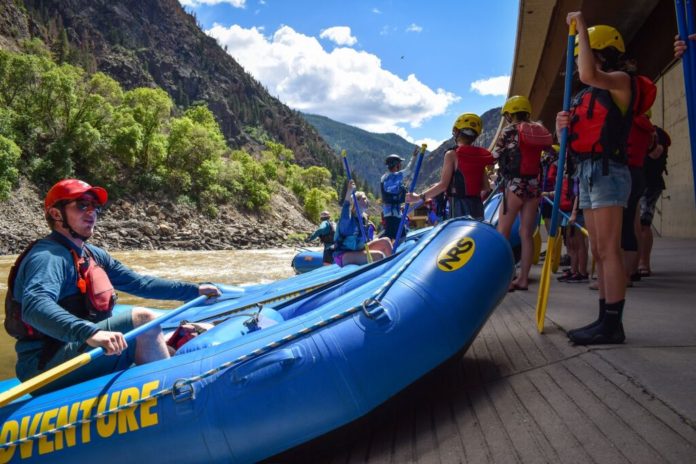Brent Gardner-Smith/Aspen Journalism
By giving up the push for a legal mechanism to secure a water right, some in Colorado’s recreation community are hoping proposed legislation will result in more water in streams for the benefit of boaters.
A new bill would allow certain public entities to create a “recreation in-channel values reach” (RIVR), a stretch of river up to 400 yards long, which is important to boaters, anglers and waders. Holders of this RIVR segment could then lease water, which would be sent downstream to boost flows in the segment.
“We are seeing it as a tool to move water to a place where it’s going to benefit the community and it provides the tool to be able to legally do that,” said Hattie Johnson, the southern Rockies stewardship director at American Whitewater.
The proposal is an attempt to carve out a spot for — and recognize the importance of — Colorado’s outdoor-recreation economy in the hierarchy of water uses, which prioritizes the oldest water rights, usually belonging to agriculture and cities.
The new bill would allow a municipality — for example, Steamboat Springs, where officials have in recent years closed a stretch of the Yampa River through town when summer temperatures are too high and flows too low — to buy and release upstream water to boost the troubled reach. It could allow communities to avoid fishing closures during late summer or to make sure flows are adequate for a boating festival.
“We see it as a way that rural communities that are looking at river-based recreation as an economic development strategy to have a tool and security to back up that investment,” said Alex Funk, director of water resources and senior counsel at the Theodore Roosevelt Conservation Partnership. “We see it as a flexible way for communities to utilize their river corridors in a creative way and support a burgeoning outdoor-recreation economy in Colorado.”
The RIVR proposal evolved from one that river-recreation groups were working on last year, which would have allowed natural river features such as a wave or a rapid to get a water right. The plan was opposed by some, including Front Range water providers, who did not want to lock up water in the river and prevent its future development.
The Pitkin County Healthy Rivers board wrote the lone letter in support of last year’s proposal and said it will probably support the RIVR bill as well. The board listened to a presentation from Johnson at Thursday’s monthly board meeting.
“It makes sense, the concept that you don’t have to build a structure,” said Healthy Rivers chair Chris Lemons.
The new proposed legislation without a secured water right is something of a concession to opponents.
“Having a legal right to the water, that’s huge,” Johnson said. “That’s how our whole system works, and it gives you standing on par with all the traditional water users, and we did give that up.”
But proponents say the new, innovative strategy has the potential to be even more effective than last year’s proposal at ensuring that there is enough water for recreation. Under Colorado water law, older water rights have first use of the river.
“Under the traditional water-right process, these would have been extremely junior in terms of their priority date, so rarely, if ever, could have called out water to meet this need,” Funk said. “With the older model, you have the security of a water right, but it was always going to be low on the tier.”
Brent Gardner-Smith/Aspen Journalism
Environmental and recreation interests typically have taken a backseat to traditional water users such as agriculture and cities, even as Colorado’s economy is increasingly fueled by outdoor recreation and tourism. The recognition of recreation as a “beneficial use” of water happened only two decades ago with the creation of a recreational in-channel diversion (RICD) water right.
Several communities around the state have RICDs, which give a water right to a specific river feature. But these must be human-made, such as the kayak waves that Pitkin County built on the Roaring Fork River in Basalt. Last year’s effort, which was scrapped in favor of the new RIVR legislation, attempted to give RICD water rights to a naturally occurring feature.
John Kuhn, water advocate with Conservation Colorado, said the problem is that the RICD statute has not kept up with the different kinds of river recreation, such as fly-fishing and stand-up paddle boarding, the latter of which has exploded in popularity in recent years. A RICD is tailored primarily to kayakers who like playboating.
“The problem remains that Colorado water law is just not keeping up with the increased demands on rivers and streams,” Kuhn said. “(The RIVR proposal) provides greater flexibility with the way we manage our water resources and the communities that are dependent upon it.”
So far, Front Range water providers, who were opposed to last year’s proposal, have not weighed in on the new RIVR legislation. The bill has not yet been introduced in the general assembly but is expected to be sponsored by state Rep. Dylan Roberts, who represents District 26 in Eagle and Routt counties.
Aspen Journalism covers water and rivers in collaboration with The Aspen Times. For more, go to http://www.aspenjournalism.org.
Credit: Source link





























